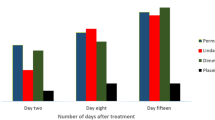Abstract
Permethrin is the most widely used pediculicide, but evidence of resistance from several countries and anecdotal reports from Germany suggest that permethrin lotion is now less effective. We designed a randomized, controlled, parallel group trial involving 100 participants with active head louse infestation to investigate the activity of a coconut and anise spray and to see whether permethrin lotion is still effective, using two applications of product 9 days apart. The spray was significantly more successful (41/50, 82.0%) cures compared with permethrin (21/50, 42.0%; p < 0.0001, difference 40.0%, 95% confidence interval of 22.5% to 57.5%). Per-protocol success was 83.3% and 44.7%, respectively. Thirty-three people reported irritant reactions following alcohol contact with excoriated skin. We concluded that, although permethrin lotion is still effective for some people, the coconut and anise spray can be a significantly more effective alternative treatment.

Similar content being viewed by others
References
Burgess IF (1999) Dermatopharmacology of antiparasitics and insect repellents. In: Gabard B, Elsner P, Surber C, Treffel P (eds) Dermatopharmacology of topical preparations. Springer-Verlag, Heidelberg, pp 157–178
Burgess IF, Brown CM (1999) Management of insecticide resistance in head lice, Pediculus capitis (Anoplura: Pediculidae). Proceedings of the 3rd International Conference on Control of Urban Pests, Prague, pp 249–253
Burgess IF, Lee PN, Matlock G (2007) Randomised, controlled, assessor blind trial comparing 4% dimeticone lotion with 0.5% malathion liquid for head louse infestation. PLoS ONE 2(11):e1127. doi:10.1371/journal.pone.0001127
Burgess IF, Lee PN, Brown CM (2008) Randomised, controlled, parallel group clinical trials to evaluate the efficacy of isopropyl myristate/cyclomethicone solution against head lice. Pharm J 280:371–375
Downs AMR, Stafford KA, Coles GC (1999) Head lice: prevalence in schoolchildren and insecticide resistance. Parasitol Today 15:1–3. doi:10.1016/S0169-4758(98)01361-1
Durand R, Millard B, Bouges-Michel C et al (2007) Detection of pyrethroid resistance gene in head lice in schoolchildren from Bobigny, France. J Med Entomol 44:796–798. doi:10.1603/0022-2585(2007)44[796:DOPRGI]2.0.CO;2
Hemingway J, Miller J, Mumcuoglu KY (1999) Pyrethroid resistance mechanisms in the head louse Pediculus capitis from Israel: implications for control. Med Vet Entomol 13:89–96. doi:10.1046/j.1365-2915.1999.00141.x
Kristensen M (2005) Identification of sodium channel mutations in human head louse (Anoplura: Pediculidae) from Denmark. J Med Entomol 42:826–829. doi:10.1603/0022-2585(2005)042[0826:IOSCMI]2.0.CO;2
Mumcuoglu KY, Miller J, Zamir C et al (2002) The in vivo pediculicidal efficacy of a natural remedy. Isr Med Assoc J 4:790–793
Oliveira FAS, Speare R, Heukelbach J (2007) High in vitro efficacy of Nyda®L, a pediculicide containing dimeticone. J Eur Acad Dermatol Venereol 21:1325–1329. doi:10.1111/j.1468-3083.2007.02258.x
Picollo MI, Vassena CV, Casadio AA et al (1998) Laboratory studies of susceptibility and resistance to insecticides in Pediculus capitis (Anoplura; Pediculidae). J Med Entomol 35:814–817
Scanni G, Bonifazi E (2005) Efficacy and safety of a new non-pesticide lice removal product. Eur J Pediatr Dermatol 15:49–52
Thomas DR, McCarroll L, Roberts R et al (2006) Surveillance of insecticide resistance in head lice using biochemical and molecular methods. Arch Dis Child 91:777–778. doi:10.1136/adc.2005.091280
Yoon KS, Gao JR, Lee SH et al (2003) Permethrin-resistant human head lice, Pediculus capitis, and their treatment. Arch Dermatol 139:94–1000. doi:10.1001/archderm.139.8.994
Yoon KS, Gao JR, Lee SH et al (2004) Resistance and cross-resistance to insecticides in human head lice from Florida and California. Pestic Biochem Physiol 80:192–201. doi:10.1016/j.pestbp.2004.07.008
Acknowledgements
This study was supported financially by Omega Pharma NV, Nazareth, Belgium, which played no active role in the design of the study, interpretation of the results, or the writing of the manuscript. We wish to thank Dr Marc Dams and Isabelle Dedeken for administrative support. Thanks also to Laurence Noiroux of S-Clinica, Brussels, Belgium for statistical analyses. Investigation team members who contributed to the study but were not named as authors were Ian Jones, Audrey Pepperman, and Christine Sullivan. Medical supervision for clinical queries was provided by Dr Paul Silverston.
Author information
Authors and Affiliations
Corresponding author
Rights and permissions
About this article
Cite this article
Burgess, I.F., Brunton, E.R. & Burgess, N.A. Clinical trial showing superiority of a coconut and anise spray over permethrin 0.43% lotion for head louse infestation, ISRCTN96469780. Eur J Pediatr 169, 55–62 (2010). https://doi.org/10.1007/s00431-009-0978-0
Received:
Accepted:
Published:
Issue Date:
DOI: https://doi.org/10.1007/s00431-009-0978-0



